Introduction
Understanding the complexities of Stage 2 Autism is crucial for those supporting children on the spectrum. This condition presents challenges in social interaction and communication, with children often finding it hard to interpret and respond to social signals. Their verbal and nonverbal communication skills may be limited, and they might exhibit repetitive behaviors or intensely focus on specific interests.
Navigating the unique needs of a child with Stage 2 Autism can be a profound journey for families, marked by seeking effective interventions and understanding the latest research in autism care. In this article, we explore the characteristics and challenges of Stage 2 Autism, the diagnostic criteria and process, educational accommodations and strategies, therapeutic approaches and treatment options, parental advocacy and support strategies, and strategies for promoting positive behavior. By providing guidance and resources, we aim to empower parents to navigate the challenges and ensure the well-being of their children on the autism spectrum.
What is Stage 2 Autism?
Comprehending the intricacies of moderate Autism, frequently referred to as Stage 2, is essential for those assisting youngsters on the spectrum. This condition presents challenges in social interaction and communication, with individuals often finding it hard to interpret and respond to social signals. Their verbal and nonverbal communication skills may be limited, and they might exhibit repetitive behaviors or intensely focus on specific interests.
For families, navigating the unique needs of a child with Stage 2 Autism can be a profound journey, marked by seeking the most effective interventions and understanding the latest research in autism care. An approach that focuses on meeting needs is advised, with an emphasis on early identification and prompt assistance that doesn't only rely on diagnosis. This proactive strategy is vital because delayed or inadequate support can lead to exacerbated issues, such as mental health conditions or educational challenges.
The narrative of a parent grappling with their offspring's unexpected seizures on a Bank Holiday underscores the unpredictable nature of a developmental disorder and the need for continuous vigilance and adaptability in care strategies. Moreover, with the emergence of new therapies and medications, caregivers must stay informed to make the best decisions for their child's well-being.
It's also essential to recognize the diversity within the spectrum of individuals with ASD, as not all individuals experience the same challenges or possess the same strengths. Some individuals, often referred to as having high functioning, demonstrate higher intellectual abilities and milder symptoms, though they still face hurdles, especially in social scenarios.
Finally, awareness and understanding about autism must extend beyond families to society at large. The employment rate for autistic individuals is significantly lower than the general population, revealing systemic barriers that must be addressed. Efforts to raise awareness, reduce stigma, and capitalize on the unique talents of autistic people are ongoing, aiming to create a more inclusive workforce and society.
Characteristics and Challenges of Stage 2 Autism
Navigating the intricate terrain of Stage 2 Autism can be challenging for youngsters and their families. These individuals might struggle with social interactions, showcasing a tendency towards repetitive behaviors and a limited scope of interests which can make it difficult for them to form and maintain relationships. Sensory sensitivities are also common, often leading to overwhelming experiences in everyday settings. By comprehending these characteristics, those looking after these children can more effectively customize their assistance, guaranteeing interventions are both suitable and efficient.
Clinicians and researchers continually work to refine intervention strategies, basing their decisions on the latest evidence from research studies. Randomized controlled trials, which are increasingly common in research on the condition, provide strong data that can guide optimal approaches for intervention and assistance. A move towards such evidence-based approaches is vital in tackling the present autism assessment and crisis emphasized by recent reports. These reports advocate for an approach centered on the needs of autistic individuals, replacing the system that prioritizes diagnosis. The focus is on early identification and prompt assistance that is not reliant on diagnosis, in order to enhance outcomes for individuals on the autism spectrum.
The importance of this approach is emphasized by statistics that show a significant number of individuals with autism are waiting for extended periods - sometimes years - for the necessary health and education support. This delay can exacerbate issues, including mental health challenges and the risk of school exclusion. As such, staying current with new research findings, treatments, and medications is vital for caregivers, ensuring they can make informed decisions about their child's care.
Autism's complexity is highlighted by its characterization as a spectrum condition, with a variety of behaviors and degrees of impact. No single cause of autism has been identified, but early diagnosis is crucial in accessing resources that facilitate a fulfilling life. While brain structure differences have been observed in people with autism, misconceptions about its causes, such as incorrect links to vaccines, persist. It's essential for caregivers to start conversations with healthcare providers early on to navigate the path of evaluations and interventions effectively.
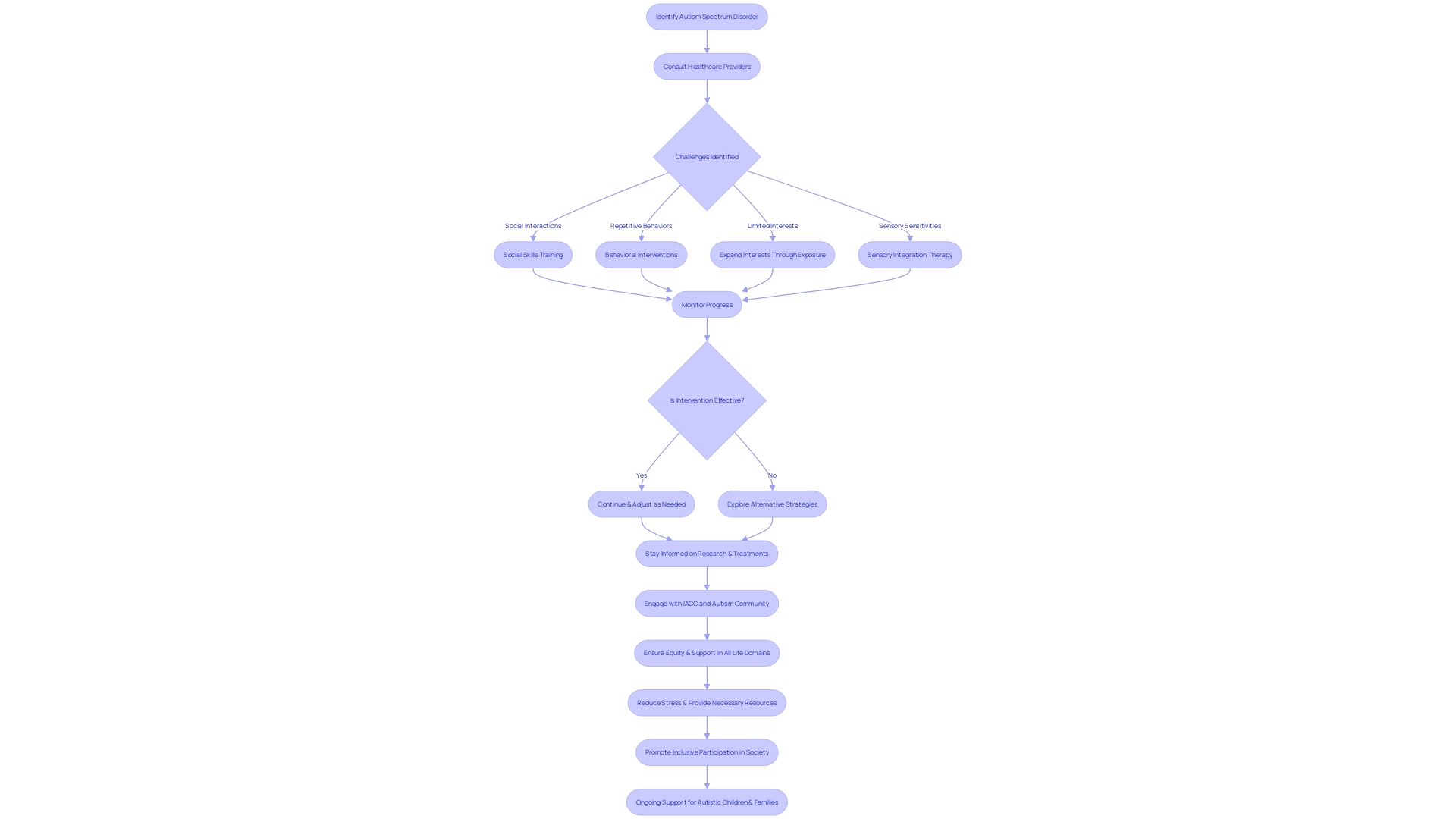
Diagnostic Criteria and Process for Stage 2 Autism
Comprehending the diagnostic process for Autism Spectrum Disorder (ASD) is crucial, as it allows for timely access to resources and assistance that can greatly improve the quality of life for individuals with ASD. According to the American Psychiatric Association's Diagnostic and Statistical Manual (DSM-5), ASD is characterized by persistent differences in communication, social interactions, and by restricted and repetitive behaviors. These symptoms can manifest in various ways, such as repeating sounds or phrases (echolalia), showing an intense preference for sameness, and experiencing hypersensitivity or reduced sensitivity to sensory input.
The Centers for Disease Control and Prevention (CDC) estimates that ASD may affect as many as 1 in 36 individuals, highlighting the prevalence of the condition. Despite the significance of an official diagnosis for accessing specific forms of assistance, it's worth mentioning that the autistic and neurodivergent community is receptive to self-diagnosis, acknowledging the constraints of medical testing, which frequently yields inconclusive outcomes for numerous adults. Therefore, an official diagnosis is not deemed necessary by some within this community unless it directly impacts the support they require.
Recent advancements in diagnostic tools show promise in streamlining the process. A study by Kristiina Tammimies from the Karolinska Institutet developed machine-learning models like 'AutMedAI' which, using a combination of 28 parameters, could identify about 80% of children with a developmental disorder before 24 months of age. Organizations such as The Autism Community in Action (TACA) emphasize that starting behavioral therapy and other treatments earlier leads to improved outcomes. Efforts by companies like NeuroQure aim to dramatically reduce the time it takes to receive a diagnosis, from a multi-year journey to just a few weeks after birth. This is particularly crucial for families with a higher risk due to genetic factors.
It is important for those involved in the care and advocacy for individuals with ASD to be aware of the signs and symptoms as well as the diagnostic criteria set out in the DSM-5. By doing so, they can ensure that individuals receive the necessary evaluations and interventions to thrive. As awareness and understanding of autism continue to grow, the community's approach to diagnosis and assistance evolves, too, focusing on individual needs and the diverse expressions of autism across the spectrum.
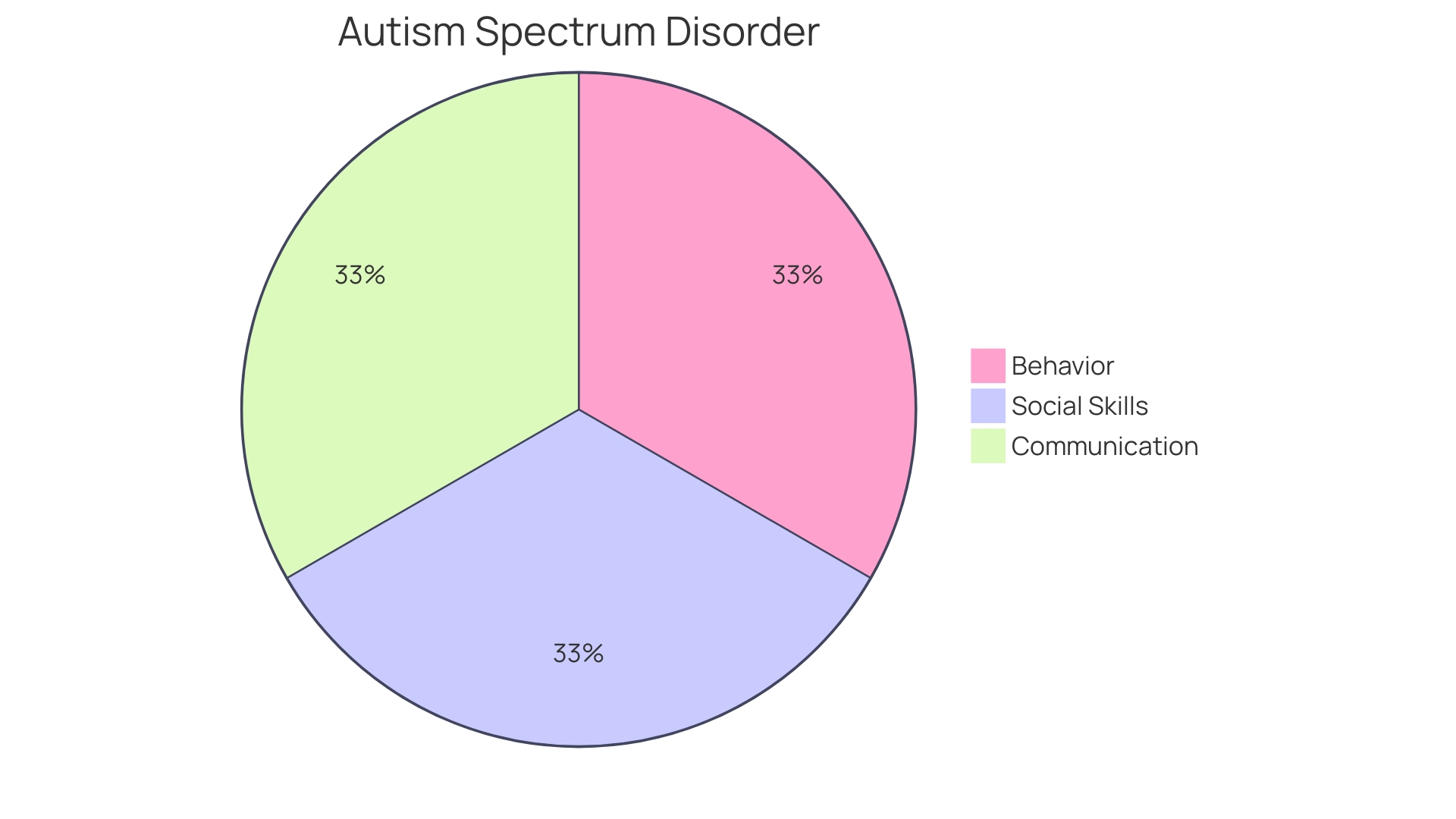
Educational Accommodations and Strategies for Stage 2 Autism
When youngsters diagnosed with Stage 2 Autism transition into educational settings, it becomes crucial to customize educational adjustments and approaches to their distinct abilities. The formation of individualized education plans (IEPs), along with specialized instruction, access to assistive technology, and supportive services, are pivotal steps in this process. Collaborative efforts between parent advocates, educators, and school administrators are key to developing a comprehensive plan that fosters both the academic and social growth of these students.
In light of recent statistics revealing that only about 3 in 10 working age autistic individuals are employed, compared to 5 in 10 of all disabled individuals, there is a pressing need to address inclusion from an early stage. This gap highlights the significance of providing children with the skills and assistance needed to prosper in future work environments. As echoed by a review launched on World Autism Awareness Day, enhancing public awareness and understanding of this condition is crucial. This collaborative initiative relies on insights from employers, autism charities, and specialist aid groups, aiming to enhance employment rates for autistic individuals over the next five years.
There is evidence to back the idea of inclusion through innovative programs such as those provided by Emirates and Dubai International Airport, which have implemented rehearsal flying experiences for children who are neurodivergent. These programs demonstrate how real-world applications of supportive practices can significantly enhance the experiences of autistic individuals.
The legal and policy landscape reinforces the importance of inclusion, with documents such as those from the Individuals with Disabilities Education Act (IDEA) emphasizing the necessity for States and local agencies to implement programs that promote high-quality individualized programming. Furthermore, parents have a vital part as knowledgeable supporters for their offspring, keeping up to date with recent discoveries and therapies, and making well-informed choices about their offspring's well-being and schooling. As one parent advocate states, understanding the benefits and risks of each medication and therapeutic approach is vital, and ongoing education is paramount to staying current and effective in advocacy efforts.
Ultimately, the objective is to guarantee that individuals with autism are not only included but also provided with the resources and support to participate fully and equitably in all aspects of life, from early childhood programs to future employment opportunities.
Therapeutic Approaches and Treatment Options for Stage 2 Autism
Selecting the appropriate therapeutic approach for an individual with Stage 2 Autism involves personalized care and attention. While Applied Behavior Analysis (ABA) therapy, speech therapy, occupational therapy, and social skills training are valuable, it's crucial to customize interventions to the individual's specific needs. This personalized attention corresponds with the belief that every individual deserves a just and encouraging 'race,' as expressed by Dr. David (Dan) R. Offord. The objective is to promote a setting where youngsters with developmental challenges can flourish intellectually, at home, and socially, while guardians have the essential resources to cultivate their growth.
Moreover, innovative techniques like neurofeedback offer promising results by improving cognitive abilities, mood regulation, and reducing hyperactivity. As the Community in Action (TACA) emphasizes, early and accurate diagnosis followed by timely intervention is crucial to better outcomes. Groundbreaking advancements from companies like NeuroQure demonstrate the strides being made in early detection, potentially transforming the diagnostic journey for ASD.
Staying abreast of new findings and treatments is part of this dynamic field. Parents are encouraged to continually educate themselves on the benefits and risks of therapies, as mentioned by a proactive caregiver. With a treatable condition like ASD, it is crucial to stay informed and seek guidance from experts to guarantee that children get the assistance they require for a well-rounded and satisfying life.
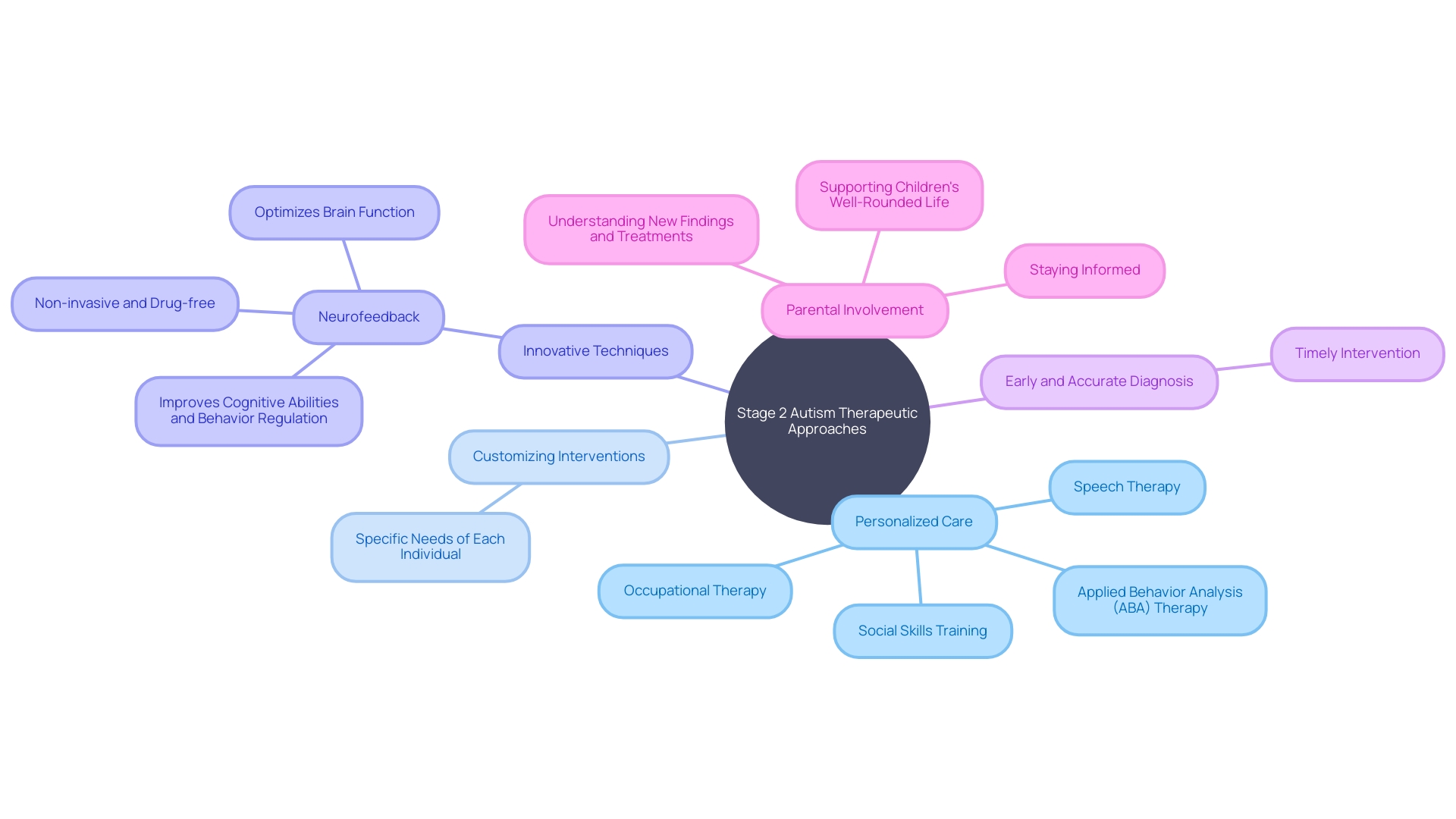
Parental Advocacy and Support Strategies for Stage 2 Autism
Navigating the complexities of Stage 2 Autism requires vigilance and a proactive stance from parents, who are often the primary advocates for their offspring. Engaging in the educational process through Individualized Education Program (IEP) meetings is just one facet of this multifaceted role. Parents must also cultivate partnerships with healthcare professionals and tap into the network of support provided by groups and organizations that understand the intricacies of autism.
Equipping oneself with knowledge about a young person's rights and the variety of resources available is paramount. Being actively engaged in the care and educational journey of their offspring can result in significant achievements, similar to the father who, motivated by his son's usage of an electronic tablet for communication, obtained funding for picture boards to assist non-speaking individuals. His story exemplifies the transformative impact that informed and determined parent advocacy can have.
With the constantly changing field of treatments, medications, and therapeutic techniques, it is crucial for parents to stay up-to-date on new advancements that may benefit their offspring. Caregivers must critically evaluate the pros and cons of prescribed medications and be attentive to any behavioral changes, ensuring that any internet-sourced information is corroborated by experts.
Supporting an individual with autism spectrum disorder comes with its own challenges, as demonstrated by the Kevin and Avonte Program, which addresses the significant issue of wandering and elopement, and the innovative efforts by Emirates and Dubai International Airport to enhance the travel experience for passengers with neurodivergent traits. The joint endeavors of these programs and initiatives highlight the significance of community collaboration and education in establishing secure and inclusive environments for individuals with autism.
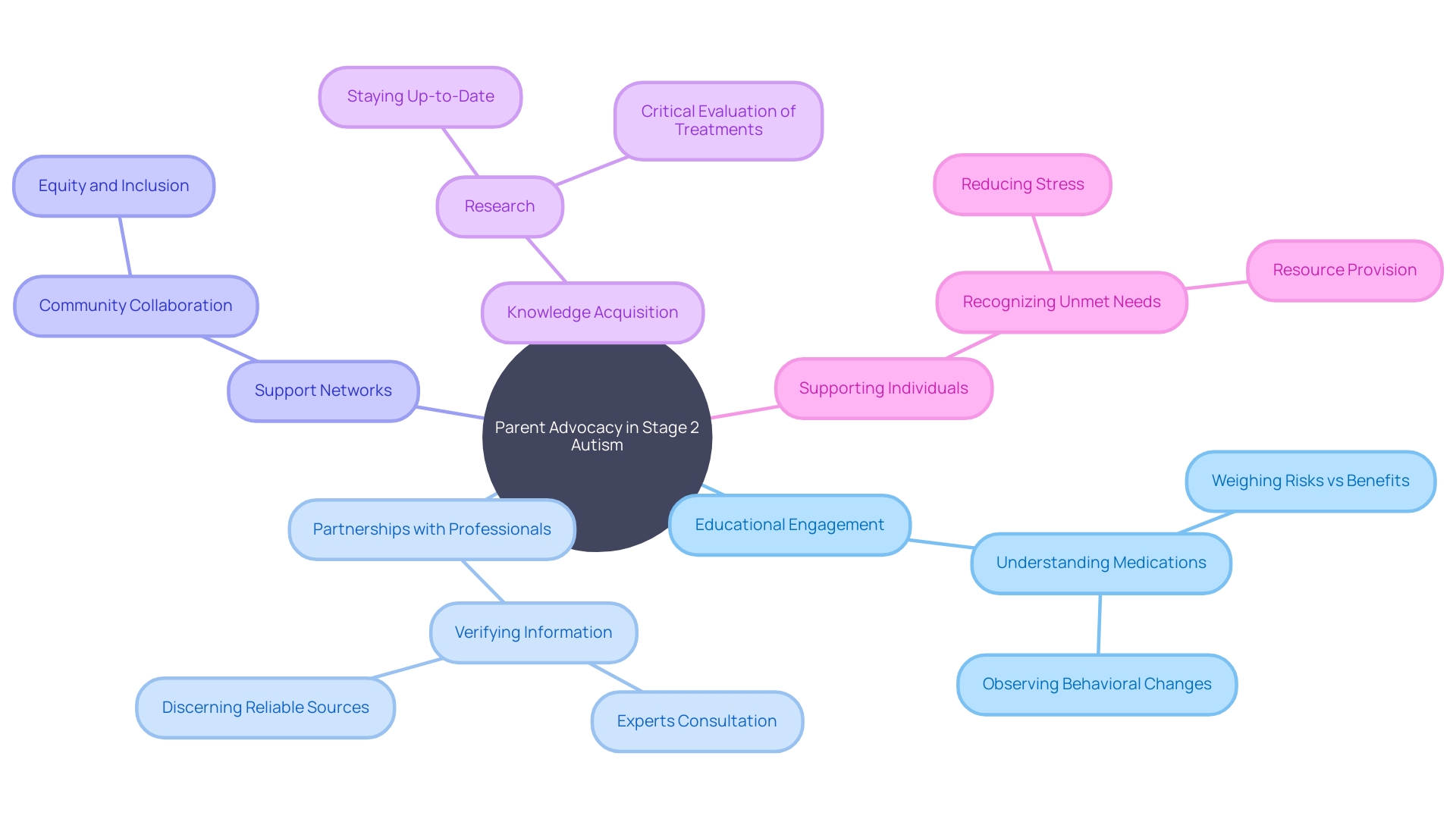
Strategies for Promoting Positive Behavior in Stage 2 Autism
Promoting positive conduct is crucial when assisting kids with Stage 2 Autism. By utilizing techniques like visual schedules, social stories, and positive reinforcement, parent advocates can successfully steer children towards positive behaviors while addressing challenging ones. These strategies should be tailored to the child's unique requirements, and crafting a personalized behavior plan should be a collaborative process with professionals.
As highlighted by the Interagency Autism Coordinating Committee (IACC), the importance of community and expert collaboration is paramount. The IACC emphasizes improving communication across the federal government and partnering with the autism community, which includes parents and family members. This collective approach ensures that strategies and interventions reflect a broad range of insights and experiences, enhancing their effectiveness and relevance.
The words of Dr. David (Dan) R. Offord remind us that equitable participation in all life domains is crucial for mental health and well-being, particularly for individuals with disabilities. This principle highlights the significance of acknowledging the distinct contributions and challenges encountered by individuals with autism.
Consistent with the perspectives shared by experts, parents must stay informed about the latest research and understand the potential benefits and risks associated with any intervention. Knowledge empowers caregivers to make informed decisions that prioritize the health and well-being of their loved one. As such, ongoing education and a critical evaluation of available information are essential steps in advocating for and supporting children on the autism spectrum.
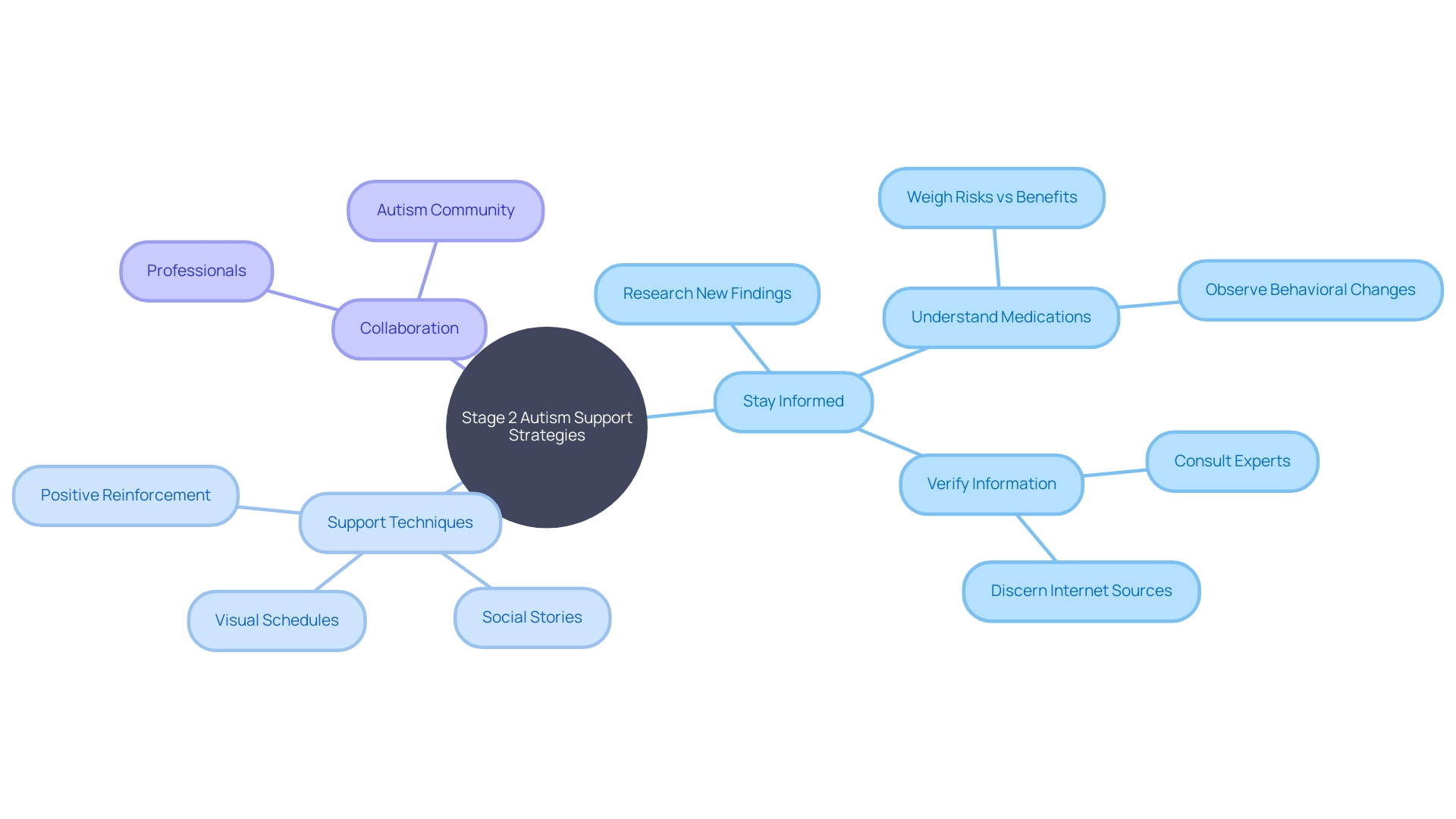
Conclusion
In conclusion, navigating the complexities of Stage 2 Autism requires a proactive and vigilant approach from parents and caregivers. Understanding the characteristics and challenges of Stage 2 Autism is crucial for tailoring support and interventions to meet the unique needs of each child. By staying informed about the latest research and advancements in autism care, parents can ensure better outcomes for their children.
Collaborative efforts between parent advocates, educators, and administrators are key to developing individualized education plans (IEPs) that foster inclusion and equip children with the skills they need to thrive in future work environments. Tailoring interventions to the unique needs of each child can foster an environment where children with autism can thrive academically, at home, and socially.
Parental advocacy is a crucial aspect of supporting children with Stage 2 Autism. Engaging in the educational process, cultivating partnerships with healthcare professionals, and tapping into the support provided by organizations that understand the intricacies of autism are vital for achieving significant breakthroughs and ensuring the well-being of the child.
Strategies for promoting positive behavior in children with Stage 2 Autism involve leveraging tools such as visual schedules, social stories, and positive reinforcement. Collaboration with professionals and the autism community is essential for developing effective behavior plans.
In conclusion, by staying informed, advocating for their children, and tailoring support to their unique needs, parents can navigate the challenges of Stage 2 Autism and ensure the well-being and success of their children on the autism spectrum.




